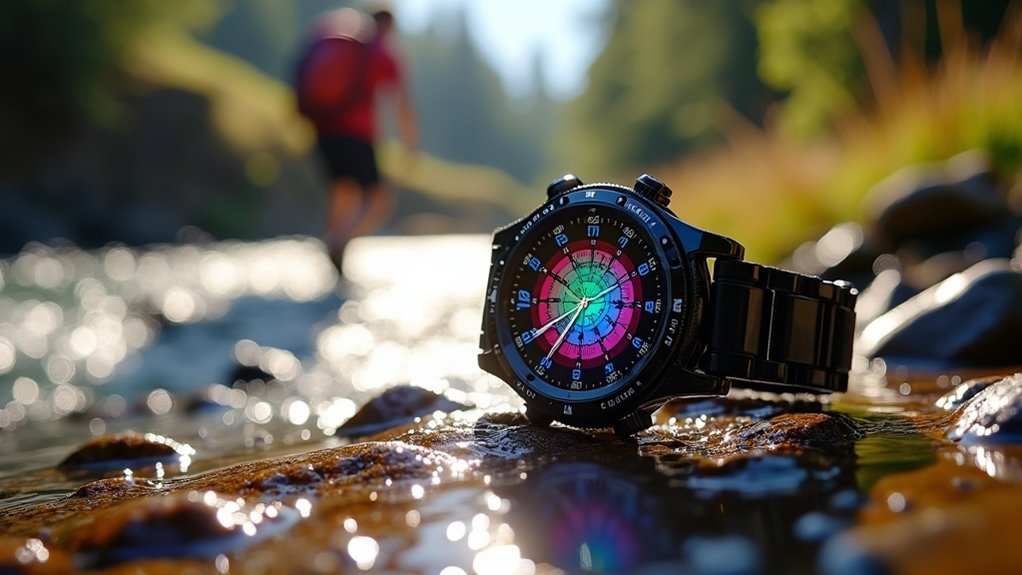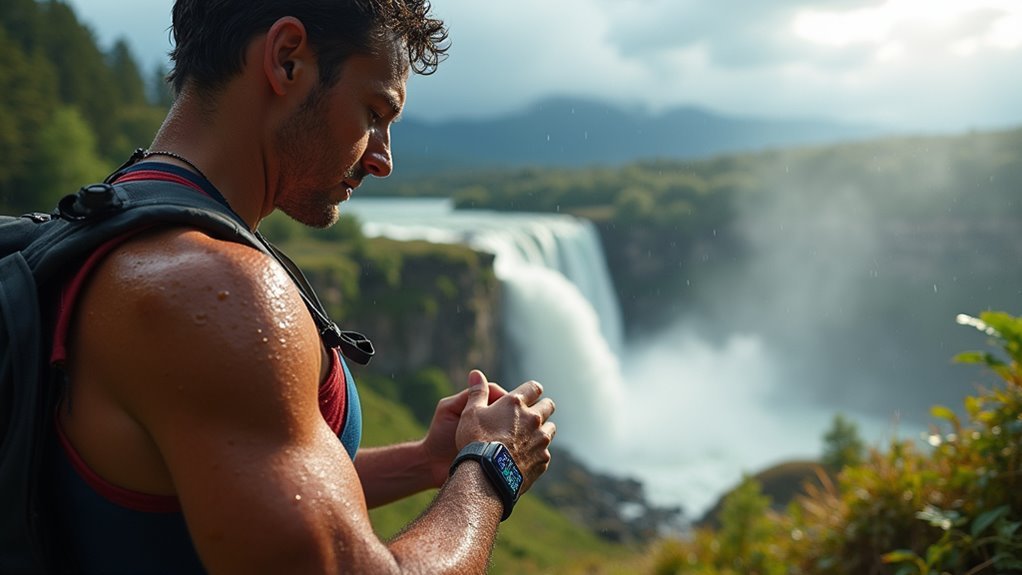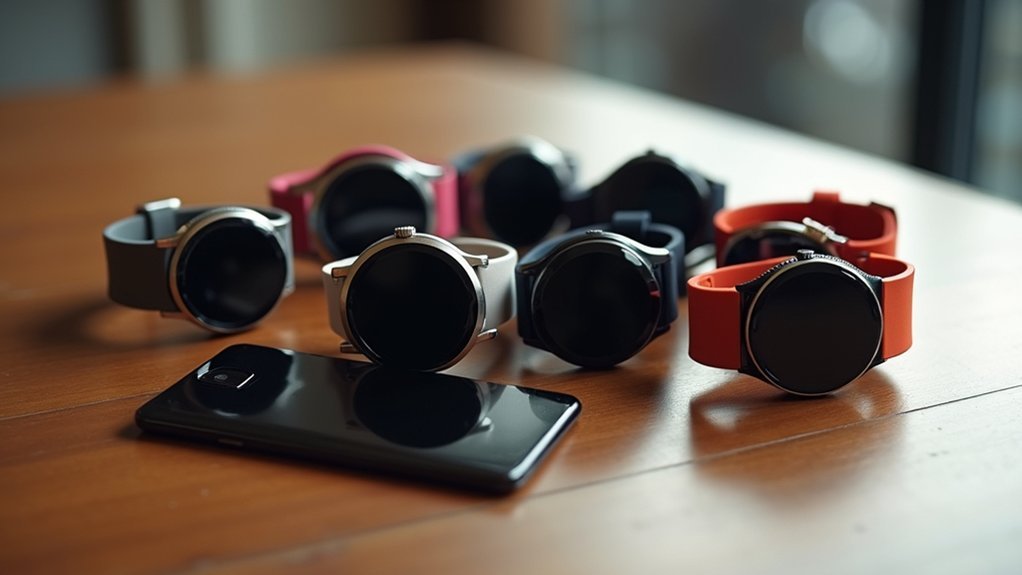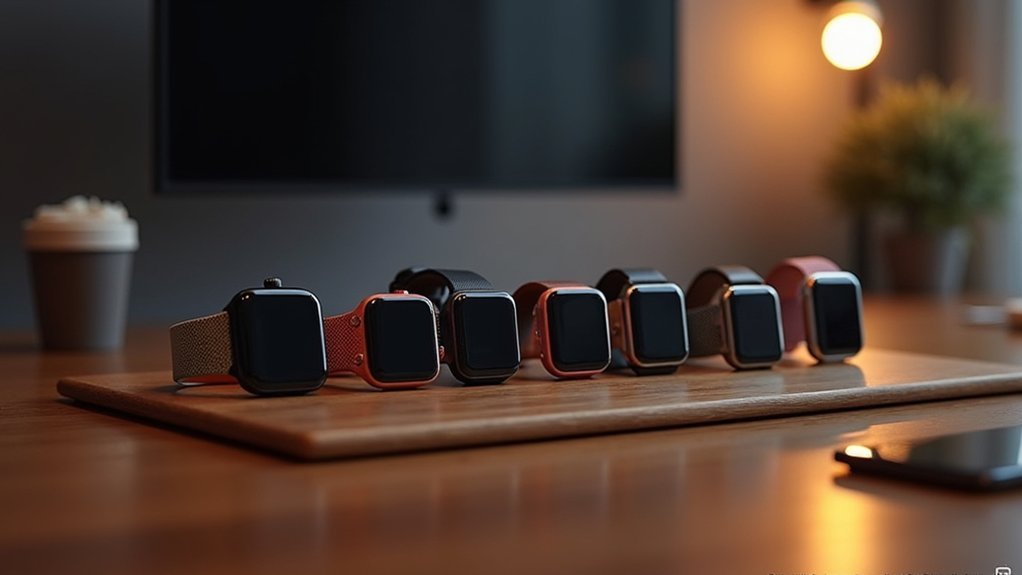Waterproof displays are essential for your active lifestyle because they maintain reliable performance during swimming, hiking in rain, and intense workouts where sweat could damage standard screens. With IP67 or IP68 ratings, these displays resist water submersion up to 1.5 meters while providing accurate real-time metrics for stroke mechanics, heart rate monitoring, and hydration tracking. They’re built with rugged materials and specialized coatings that withstand environmental stress, ensuring your fitness data remains accessible regardless of weather conditions. Discover how these advanced technologies can transform your training experience.
Understanding Water Resistance Standards and Ratings

Three primary standards determine how well your display can handle water exposure: IP (Ingress Protection), JIS (Japanese Industrial Standard), and ATM (atmospheres).
IP ratings are most common for electronics, using two digits where the second indicates water resistance from IPX0 (no protection) to IPX9. You’ll typically see IP67 or IP68 rated as waterproof, with IP68 handling continuous submersion at 1.5 meters.
IP68 offers the highest consumer waterproof rating, protecting electronics during continuous underwater submersion up to 1.5 meters deep.
JIS focuses on Japanese industrial applications but lacks clear consumer labeling.
ATM measures pressure resistance—1 ATM equals 10 meters of water pressure—and dominates the watch industry. However, ATM tests use water jets, not true depth submersion. Movement during water exposure can significantly alter water pressure impacts on your device.
Understanding these distinctions helps you choose displays that match your activity level and water exposure needs.
Protection Against Environmental Stress and Daily Wear
Beyond their ability to repel water, waterproof displays face a gauntlet of environmental challenges that can compromise performance and lifespan.
You’re dealing with humidity fluctuations, temperature extremes, chemical exposure from cleaning products, and UV light that degrades materials over time. Waterproof displays combat these threats through chemical-resistant coatings and advanced seal designs that prevent moisture ingress even under pressure.
Daily wear presents additional challenges you’ll appreciate having protection against.
Scratch-resistant glass shields against drops and impacts, while specialized coatings prevent fingerprints and smudges from compromising clarity. Dust can’t penetrate sealed displays, preventing internal accumulation that damages components. Weather monitoring applications require displays that can withstand environmental conditions similar to those encountered in outdoor data collection scenarios.
Your waterproof display won’t show water spots or mineral deposits, maintaining visual clarity after exposure to moisture while greatly extending overall device lifespan.
Enhanced Performance During Water-Based Activities
When you’re swimming laps or competing in water sports, you need precise data to optimize your technique and push your limits.
Waterproof displays transform your training by delivering real-time metrics on stroke mechanics, lap times, and distance covered without interrupting your flow.
You’ll gain the accuracy required to make immediate adjustments and track meaningful progress in challenging aquatic environments. The integration of wearable technology in water sports gear is becoming increasingly popular as athletes seek enhanced performance tracking capabilities.
Swimming Performance Tracking
How can swimmers release their full potential in the water?
You’ll achieve breakthrough performance when you leverage swim tracking technology that captures critical metrics like distance per stroke, stroke rate, and underwater time. These waterproof devices automatically record data that coaches previously collected manually with stopwatches, eliminating human error and providing unprecedented accuracy.
You’ll receive real-time feedback on poolside displays, enabling instant technique adjustments during training. Your coach can modify intensity or stroke mechanics as deviations occur, optimizing each session’s effectiveness.
Long-term data storage reveals performance trends, identifying consistent strengths and recurring weaknesses across seasons. Since World Aquatics now permits data collection devices during official competitions, swimmers can gather comprehensive race metrics for post-event analysis and strategy refinement.
This extensive tracking approach transforms how you train, with the global swimming fitness tracking market projected to reach $13.71 billion by 2033, reflecting swimmers’ growing demand for actionable performance insights.
Water Sports Accuracy
While standard fitness trackers excel on dry land, water environments present unique challenges that can greatly compromise measurement accuracy. Your heart rate readings can deviate by 13 to 56 beats per minute during swimming, with precision confidence intervals widening greatly – for example, the Garmin Venu Sq’s margin shifts from [-14,12] bpm dry to [-117,30] bpm wet.
Your arm movements create additional interference, making wrist-worn devices less reliable than chest-strap monitors. Step counting accuracy drops considerably as altered motion dynamics confuse detection algorithms. Recent research with 27 participants demonstrated significant variability in step count accuracy between different water-resistant monitors during underwater treadmill testing.
Water creates capacitive interference that affects touch controls, reducing your ability to access real-time feedback.
Waterproof displays with advanced signal processing help maintain data integrity, ensuring you receive accurate performance metrics when swimming, surfing, or participating in other water sports.
Durability Benefits for Outdoor Sports and Adventures
Since outdoor sports and adventures expose equipment to unpredictable weather conditions, waterproof displays deliver the rugged durability you need for reliable performance.
You’ll get displays that withstand rain, snow, and humidity without malfunction, featuring high IP67 ratings that prevent water and dust ingress. They’re engineered to endure physical impacts from equipment or athletes while resisting vibrations from vehicles and machinery.
You’ll benefit from reduced repair needs due to durable construction, with faster module replacements taking just 13 seconds for some models.
These displays maintain operational stability during temperature fluctuations and remain visible in direct sunlight with brightness up to 2,500 cd/m². Their energy-efficient design also reduces operational costs during extended outdoor use.
They’re tested for reliability during repeated setup and transport, ensuring consistent performance throughout your extended outdoor adventures.
Health Monitoring Capabilities in All Weather Conditions
You can track your heart rate during intense rainfall without worrying about display malfunction, ensuring continuous fitness data collection regardless of weather conditions.
Your waterproof display maintains accurate sleep pattern analysis even when you’re sweating heavily during overnight camping trips or humid environments.
Weather-independent hydration monitoring becomes effortless since your device won’t fail when exposed to rain, snow, or extreme moisture while you’re pushing through challenging outdoor activities.
Professional-grade displays built with stainless steel housing provide the durability needed for extreme outdoor adventures where regular screens would fail completely.
Rain-Resistant Heart Rate Tracking
When rain starts falling during your morning jog, you don’t want to worry about whether your heart rate monitor will keep working.
Rain-resistant heart rate tracking guarantees you’ll receive continuous, accurate data regardless of weather conditions. Your device maintains its performance in wet environments, providing real-time feedback that’s essential for adjusting workout intensity safely.
Here are three key benefits of rain-resistant heart rate monitoring:
- Continuous Data Collection – Your device tracks heart rate without interruption, even during heavy downpours.
- Accurate Health Insights – Wet conditions won’t compromise the precision of your cardiovascular data.
- Safety Alerts – Warning systems for abnormal heart rate patterns continue functioning when you need them most.
This reliability keeps your fitness routine consistent year-round while protecting your investment from water damage. Modern waterproof fitness trackers can withstand depths of 50 meters, making them suitable for swimming and intense water-based activities.
Sweat-Proof Sleep Pattern Analysis
During those restless nights when your body naturally produces more heat and sweat, waterproof sleep trackers continue monitoring your sleep patterns without missing critical data points.
You’ll receive accurate sleep cycle analysis even when moisture would typically compromise standard devices. These sweat-proof trackers maintain consistent heart rate monitoring, blood oxygen measurements, and skin temperature readings throughout humid conditions.
Your tracker’s waterproof design guarantees reliable data collection during hot summer nights or intense workout recovery periods. This consistent performance means you’ll get thorough insights into your sleep quality regardless of environmental conditions.
The IP68 or 5ATM ratings protect against moisture interference, allowing continuous monitoring of your sleep stages, duration, and overall patterns. You can trust your device’s accuracy whether you’re sleeping in air conditioning or dealing with night sweats. Professional reviewers conduct extensive testing over weeks to months to verify these waterproof claims perform reliably in real-world conditions.
Weather-Independent Hydration Monitoring
Modern waterproof fitness trackers expand beyond sleep monitoring to track your hydration levels across all weather conditions and activities.
You’ll receive consistent data whether you’re swimming in chlorinated pools, hiking through torrential rain, or sweating during intense summer workouts. These devices maintain sensor integrity through water-resistant materials, ensuring accurate readings regardless of environmental exposure.
Your tracker’s advanced sensors continuously monitor hydration alongside heart rate and other essential signs, transmitting data wirelessly to your smartphone or healthcare provider. These wearable devices can also monitor glucose levels and oxygen saturation for comprehensive health tracking:
- Real-time alerts notify you of dehydration risks during any weather condition
- AI-powered recommendations provide personalized hydration advice based on activity and climate data
- Seamless data collection continues uninterrupted through rain, snow, or high humidity
This weather-independent monitoring helps you optimize performance and maintain proper hydration across all activities.
Advanced Materials and Waterproofing Technologies
While traditional displays crumble under exposure to rain, dust, and extreme temperatures, waterproof displays rely on sophisticated materials and engineering techniques that transform fragile electronics into rugged, weather-resistant powerhouses.
Advanced engineering transforms vulnerable electronics into weatherproof displays that thrive where traditional screens fail completely.
You’ll find these displays built with mild steel and thermally toughened glass that withstand harsh weather and physical impacts. Tempered glass screens resist scratches while UV-resistant coatings prevent sun damage.
Specialized waterproof coatings and rubber gaskets create complete encasement, achieving IP ratings from IP55 to IP68—where IP68 means full dust protection and prolonged water submersion resistance.
Advanced lamination methods bond touch layers without compromising sensitivity, while projected capacitive touchscreen technology maintains responsiveness even when wet. Optical bonding techniques further reduce glare and strengthen the display structure while preventing internal condensation.
Internal airflow systems prevent moisture condensation, ensuring your display performs reliably regardless of environmental conditions.
Cost-Effectiveness and Long-Term Value
Although waterproof displays demand a higher upfront investment than standard screens, they deliver exceptional long-term value through reduced replacement costs and minimal maintenance requirements.
You’ll benefit from their durable construction that withstands harsh environments, eliminating frequent replacements that plague standard displays.
Your investment pays off through three key advantages:
- Extended lifespan – Waterproof displays last considerably longer than conventional screens
- Lower total cost of ownership – Despite higher initial costs, you’ll save money over time
- Increased operational uptime – Reliable performance means fewer interruptions to your activities
Market trends work in your favor too.
Growing demand and technological advancements are driving down costs while improving performance. The waterproof TV market is experiencing robust growth with a projected 11.5% CAGR through 2031, indicating strong industry momentum and continued innovation.
You’re also contributing to environmental sustainability through energy-efficient technologies and reduced electronic waste from fewer replacements.
Market Demand and Consumer Preferences for Rugged Devices
As industries increasingly embrace automation and outdoor digital solutions, the rugged display market has experienced remarkable growth, reaching $10.51 billion in 2025 and projected to surge beyond $16.48 billion by 2035.
You’ll find this expansion driven by increasing demand for durable displays in marine environments, manufacturing facilities, and outdoor kiosks where waterproof touchscreen monitors alone represent a $500 million market growing at 12% annually.
Your preferences as consumers are shaping this market considerably.
You’re demanding versatile 20″ to 40″ displays that combine user-friendly interfaces with exceptional durability. The growth of IoT applications is creating additional demand for reliable interfaces that can withstand challenging environmental conditions across multiple sectors.
Whether you’re in North America or Asia Pacific regions, you’re investing heavily in automation and smart city projects that require displays capable of withstanding harsh environmental conditions while maintaining reliable performance.
Frequently Asked Questions
Can Waterproof Displays Still Be Damaged by Saltwater or Chlorinated Pool Water?
Yes, you’ll find waterproof displays can still suffer damage from saltwater and chlorinated pool water. Even with IP66 ratings and marine-grade materials, prolonged exposure weakens seals and degrades components over time.
Do Waterproof Displays Affect Touch Sensitivity When Wearing Gloves or With Wet Hands?
You’ll find waterproofing doesn’t improve glove sensitivity since standard capacitive screens still need conductive contact. However, wet hands work better with waterproof displays using advanced algorithms that reduce false touches.
How Often Should Waterproof Seals Be Inspected or Replaced on Wearable Devices?
You should inspect waterproof seals every six months with active use, or quarterly for medical applications. Replace them when you notice cracks, moisture ingress, or reduced performance to maintain protection.
Are There Specific Cleaning Products That Can Damage Waterproof Display Coatings?
Yes, you’ll damage waterproof coatings with petroleum-based cleaners, ammonia products, commercial glass cleaners, and abrasive solutions. Instead, you should use microfiber cloths with distilled water or diluted isopropyl alcohol.
Do Waterproof Displays Consume More Battery Power Than Standard Non-Waterproof Screens?
No, you won’t see increased battery drain from waterproofing alone. Your display’s power consumption depends on screen type, size, and brightness settings rather than waterproof seals or coatings.
In Summary
You’ve seen how waterproof displays transform your active lifestyle through superior protection, enhanced performance, and reliable health monitoring. Whether you’re swimming, hiking, or facing unpredictable weather, these displays won’t let you down when it matters most. The advanced materials and proven durability make waterproof displays a smart investment that’ll keep up with your adventures while delivering the functionality you need in any environment.





Leave a Reply